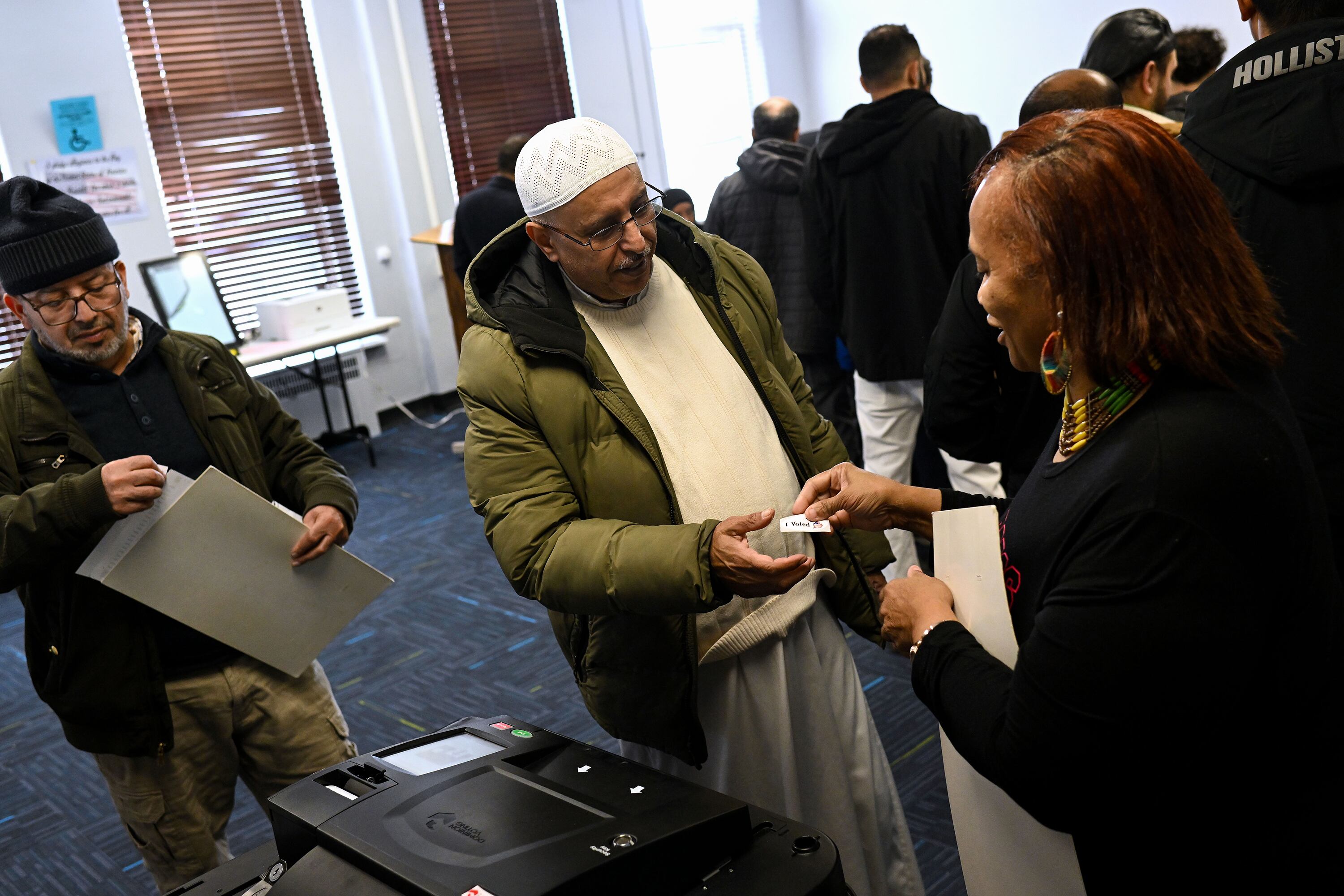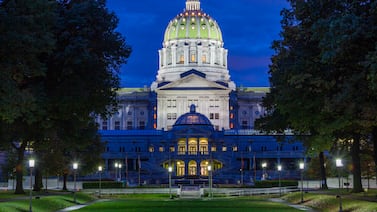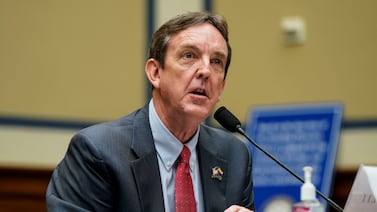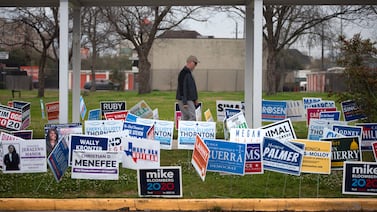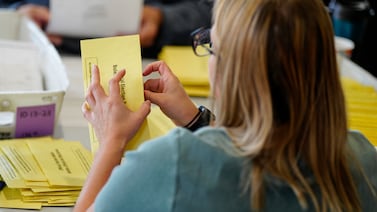Votebeat is a nonprofit news organization reporting on voting access and election administration across the U.S. Sign up for our free newsletters here.
In Michigan’s first statewide test of early in-person voting, and the first presidential primary since Donald Trump and his allies spread conspiracy theories about the 2020 election, trust appeared to be a big factor in how voters decided to cast their ballots, a Votebeat analysis shows.
The results show that 23 of the 25 counties with the highest rates of early in-person voting in last month’s primary were places that went for Trump in 2020, many by wide margins. The results suggest that people with less trust in elections and government gravitated toward the new option, including those in some Trump districts, as well as communities of color, election officials who provided the data say.
Other factors also played a role: Proximity to an early in-person polling place appears to have been a reliable predictor, and jurisdictions that provided more sites, made the process more accessible, and promoted it more vigorously also tended to see higher rates of early voting.
The results also suggest that familiarity with early in-person voting factored into rates, and officials expect a jump in early in-person rates later this year because it’s convenient and offers a sense of security.
“Early voting is a fantastic way to get under the hood and see how people engage with the election system in ways that they don’t even realize,” said Michael Siegrist, township clerk in Canton in western Wayne County. “For some it could be a novelty. For others it’s a solution, and it helps some feel comfortable with a cultural concern about fair administration of elections. It gets really layered.”
The presidential primary was the first statewide election after Michigan implemented new rules required by Proposition 2, a 2022 citizen ballot initiative approved by 60% of voters that aimed to expand voting access. Democrats and voting advocates led the campaign for Prop 2 while the state’s Republicans opposed it, and GOP lawmakers have since sued to invalidate the constitutional amendment.
Among other provisions, it mandated nine days of early in-person voting as an option. The new process allows voters to put their completed ballot in the tabulator themselves, and see that it is counted, providing a stronger sense of security than early voting through the mail, or handing an absentee ballot to a clerk.
Across the state, 78,000 out of 1.9 million voters used early in-person voting, a rate of 4.1%.
Among Michigan’s 83 counties, Antrim had the highest rate, at 13%, while Saginaw County recorded the lowest rate, 1.3%. Of the state’s 10 most populous counties, Washtenaw showed the highest rate at 7.4%
The presidential primary is a low turnout election, and the early-voting process is still new, so there is a lot of “noise” in the data, Siegrist said, but he and other observers were confident of several trends.
Voters have trust issues
In Antrim County, many voters remain distrustful of the election system nearly four years after a human error led to election night results briefly showing that the predominantly Republican county had supported Joe Biden. Despite being corrected quickly, the error helped fuel Trump’s conspiracy theories of a rigged election.
The lingering skepticism may be a huge part of why voters in Antrim, in the northern Lower Peninsula, used early in-person voting more than in any other county, said Randy Bishop, a Trump supporter and talk radio host in Antrim.
“They wanted to see the ballot being fed into the machine, and that’s why the highest percentage of early votes in the state came from my county,” said Bishop, who goes by “Trucker Randy” on his radio show, and whose wife is an election worker in Antrim County’s Torch Lake.
The link between distrust among GOP voters and the use of early in-person voting seems to be supported by the state’s partisan data, Votebeat found.
In Antrim County, 680 out of 860 early votes were cast by Republicans. In Wayne County, a Democratic stronghold, just over 5,000 of the roughly 11,200 early in-person ballots were cast in the GOP primary. Throughout the state, Republicans in rural, suburban, and urban areas turned out to vote early in relatively strong numbers, data shows
Ed Golembiewski, Washtenaw County’s chief deputy clerk, said early voting by mail and other means has always been secure, but “national politics and messaging” have fomented concern. In 2020, Trump and his allies falsely claimed that Democrats used voting by mail to commit fraud and steal the election.
The in-person option seems to allay that concern, Golembiewski said.
Michigan will keep seeing use of the early in-person option, he said, among “voters who might want the convenience of early voting without the questions they might have about absentee voting security.”
Some local municipalities with higher numbers of Black voters or immigrants who are naturalized citizens also showed high rates. Black voters historically have had some concerns about using mail-in voting, Siegrist noted.
“A lot of voters of color are very, very interested in putting their own ballot in the tabulator,” he said.
That may partially explain high rates in the city of Ann Arbor, where nearly one-third of the population are people of color, though other factors may have boosted the rate. About 11.5% of Ann Arbor voters cast ballots early in person. Dearborn, whose population has a high proportion of Arab-Americans, had a rate of nearly 5%, and Ypsilanti, whose population is about one-quarter Black, had a rate of 8.3%.
Turnout in Detroit, Flint, and Sterling Heights, all communities with relatively high numbers of people of color or naturalized immigrant citizens, showed rates of about 3.5%, which still puts them roughly among the top half of communities statewide.
In Canton Township, Siegrest found about half of those who voted “uncommitted” used early in-person voting, which he said may track with the idea that people of color are more likely to use it than absentee voting. Southeast Michigan has a high number of Arab-American voters, and they were encouraged by some Democratic leaders, including U.S. Rep. Rashida Tlaib, to vote “uncommitted” as a protest vote against Biden administration policy in the Israel-Hamas war. That said, a high number of uncommitted ballots were cast in largely white jurisdictions, as well.
Proximity and promotion boost the numbers
Other spurs for early in-person voting were proximity and promotion, Golembiewski said. Among the 23 municipalities in Washtenaw County he coordinated, Sylvan Township, which had one of the county’s six regional sites, showed the highest share of early votes, at 11.6%. Meanwhile, the city of Manchester, which was relatively far from a regional early in-person location, had the lowest at 0.9%.
Ann Arbor had six early in-person voting locations, largely placed in spots with high public traffic, like libraries. Its early voting location on the University of Michigan’s campus drew nearly 700 voters, among the highest county totals. Early voting was a convenient option for students who would be away from campus on the date of the election, which was during the university’s spring break.
“There was a high interest in the convenience of it,” said Golembiewski. “There are parts of the population that are going to have difficulty getting to the polls on election day or are skeptical of absentee voting … and that is who we saw.”
Similarly, Benzie County had 13 early in-person voting locations — one in each local municipality — and recorded the state’s fourth highest rate, 9.3%. The access undoubtedly boosted early turnout, said Benzie County Clerk Tammy Bowers.
“Each of my municipalities did it on their own, so voters were familiar with their voting area, and it was in a location where they could see it and drive past it,” she said.
By contrast, Saginaw County, which had the state’s lowest early voting rate, offered only one location for its 158,000 registered voters.
In Canton, which had two sites, the early in-person vote rate was about 5%, which exceeded Siegrist’s expectations. He attributed that partly to robust social media and mailing campaigns to raise awareness of the option. That included strategies like engaging voters daily in community discussion Facebook groups and emailing voters.
“That speaks to how important it is to do outreach,” he said.
Early-voting rates are likely to rise
The percentage of voters who use early in-person voting, just over 4% in the primary, is likely to jump to the 15% to 20% range for the next elections, officials who spoke with Votebeat estimated. Studies have found a significant increase between the first and second elections in which early in-person voting is an option, Siegrist said.
Golembiewski has seen that trend in Washtenaw County already. In Scio Township, which had an early voting location, was also one of several municipalities statewide to pilot the option in a November 2023 election. Scio saw its early in-person voting rate climb to 11.2% last month, among Washtenaw County’s highest, from 7.8% in November.
“What that’s telling me as we look forward to the rest of the year broadly, is that once you vote early once, you’re going to vote early again,” he said. “It’s the same common sense of voting generally — if you vote once, you’re likely to vote again, and I think we’ll continue to build substantially on the early voting turnout in every jurisdiction across the county and probably the state.”
Part of that success lies with how the state and clerks market the option, Siegrist said. The state now offers multiple voting options, and voters need to be informed about which option best suits their needs.
“Voters think about the voting process as often as reporters and election officials think about broccoli,” he said. “The challenge for us as election administrators is to help people understand why a certain voting method might be better for them.”
Correction: March 27, 2024: An earlier version of this story misstated the number of municipalities in Washtenaw County where Chief Deputy Clerk Ed Golembiewski coordinated elections.
Votebeat contributor Tom Perkins is a freelance reporter in Hamtramck, Michigan.


